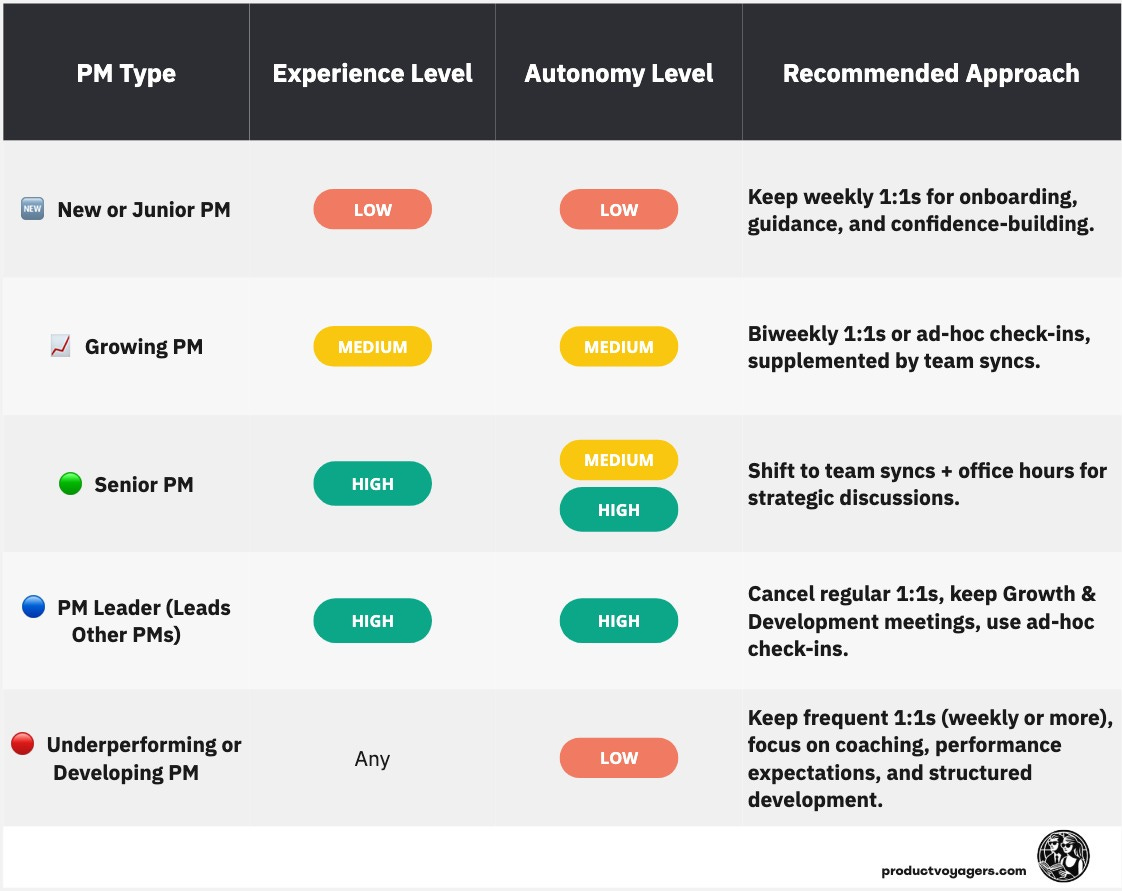Should You Cancel 1:1s? Here’s What Happened When I Did
Ditching 1:1s is trending. But is it right for you?
Recently, my feed has been flooded with stories of C- and VP-level leaders announcing they’ve stopped having 1:1 meetings with their direct reports. While that might work for them—since they mostly manage very senior people—it’s not always the right move for the rest of us. Most managers lead teams with a mix of experience levels, from junior Product Managers to seasoned leads.
So, when is the right time to cancel 1:1 meetings? And if you do, what should you replace them with?
‼️ Why I Canceled My 1:1s
Eight months ago, I made the decision to cancel my weekly 1:1 meetings with my direct reports. The turning point came when one of my Product Managers showed up to our meeting with a list of approx twenty topics. 🤯
Just looking at that list, I felt overwhelmed. But more importantly, it made me reflect on what our 1:1s had turned into:
A decision-making crutch. My direct report was treating the meeting as a time to ask me what to do rather than developing their own judgment.
A redundant status update. Most of the topics were things I already knew from Slack, team meetings, or other discussions.
An unnecessary game of telephone. Each PM was bringing up topics that were actually relevant to their peers. Instead of directly working with each other, they relied on me to relay messages, making me an unnecessary middleman.
At that moment, I realised the meetings weren’t adding value—not for me, and more importantly, not for my team. Instead of empowering PMs to make independent decisions and collaborate directly, I was unknowingly creating dependency and acting as a messenger between them.
🔋 What I Did Instead
Rather than spending 30–60 minutes in individual meetings every week, I introduced a weekly Product Sync for the entire team. Here’s why:
Encouraging team exchange. I noticed a pattern: PMs were raising topics in our 1:1s that were just as relevant for their peers. Instead of acting as a go-between, I wanted to create a space where they could discuss these topics directly.
Empowering collective decision-making. Rather than being the single decision-maker, I wanted to encourage peer collaboration. When new topics or challenges emerged, we could discuss ownership as a group.
Surfacing shared challenges. If one PM was struggling with cross-functional dependencies or blockers, others likely were too. The sync created a space to address patterns and keep a pulse on team sentiment.
👩💻 What I Gained as a Manager
By eliminating 1:1s, I freed up 3–4 hours per week—time I could now spend on more strategic work. This included:
Participating in higher-level discussions with leadership and peers.
Proactively engaging with stakeholders, rather than just reacting to updates.
Focusing on bigger-picture product strategy instead of getting lost in execution details.
🎈 What My Team Gained
At first, I was worried about how my team would adapt. But to my surprise, they quickly became more self-sufficient—relying on each other instead of just me. They even took things a step further by proactively improving processes where they had cross-team dependencies.
🥁 How I Communicated the Change
Canceling 1:1s can feel like a big shift, so I made sure to set clear expectations:
I explained the purpose of the weekly sync and how it would improve knowledge-sharing.
I reassured them that Growth & Development (G&D) meetings would continue every 4–6 weeks, so they still had structured time for career discussions.
I asked them to try it for six weeks, with a commitment to revisit if needed.
I made it clear that ad-hoc check-ins were always available for urgent or private discussions.
After six weeks, I asked for feedback. Then again at three and six months. The consensus? They didn’t miss the weekly 1:1s.
🚦 When Should You Discontinue or Adjust 1:1s?
1:1s shouldn’t be a rigid obligation. If they aren’t adding value, consider adjusting or eliminating them, especially if:
Meetings feel repetitive with no new insights. If updates can be handled asynchronously, why meet?
Your PMs are senior and self-sufficient. Experienced PMs likely don’t need weekly tactical check-ins.
Other forums cover key discussions. If your team already has strong collaboration rituals, 1:1s may be redundant.
Your direct reports prefer a different format. Some people benefit more from structured but less frequent check-ins.
🪂 When Are 1:1s Still Necessary?
Not all PMs thrive in the same setup. While team syncs work for most, some cases still warrant dedicated 1:1 meetings to provide the right level of support and guidance.
🆕 New PMs or Recent Hires → They need structured time to ask questions, seek feedback, and build confidence in their new role. Without regular 1:1s, they may struggle to navigate internal processes, understand expectations, or feel comfortable making independent decisions. A consistent cadence allows them to ramp up faster and feel supported during onboarding.
📈 Growing PMs → These are PMs who are no longer new but are still developing key skills like stakeholder management, prioritization, and decision-making. While they may not need weekly check-ins, bi-weekly 1:1s can provide a space to refine their approach to more complex challenges without fostering dependency. If they are stepping into higher ownership (e.g., leading cross-team initiatives for the first time), they may need additional guidance before transitioning to a more independent setup.
⚠️ PMs Facing Challenges → Whether it’s stakeholder misalignment, unclear priorities, or execution risks, some PMs may require extra support in navigating roadblocks. These challenges often involve nuance, influencing skills, and strategy, which are difficult to address in a group setting. In such cases, 1:1s provide a safe space to work through issues in depth and course-correct before problems escalate.
🔴 Underperforming PMs or Those Needing Development → If a PM isn’t meeting expectations—whether they lack ownership, are slow in execution, or struggle with collaboration—they likely need more frequent, hands-on coaching. If they are on a Performance Improvement Plan (PIP) or at risk of underperformance, weekly or even more frequent 1:1s ensure clear goal-setting, consistent feedback, and active skill-building. Unlike other PMs who may thrive with team syncs, struggling PMs require dedicated manager time to support their growth.
In short, not every PM needs 1:1s at the same frequency—it depends on their level of experience, independence, and current challenges. The key is to adapt the format based on the needs of each individual, ensuring they have the right level of support to grow while maintaining autonomy where possible.
🧭 Decision Matrix: Should You Cancel 1:1s?
I created this framework to help Product Leaders make intentional decisions about when to adjust, reduce, or maintain 1:1s while ensuring their team stays supported and empowered. Use it to assess whether 1:1s are essential for each of your direct reports based on their experience level and independence.
🔍 Alternatives to Traditional 1:1s
If you decide to reduce or eliminate weekly 1:1s, you can still maintain strong communication through:
Ad-hoc check-ins – 15-minute spontaneous chats when needed.
Asynchronous updates – Slack, Notion, or email summaries for progress tracking.
Team discussions – Encouraging peer collaboration instead of relying solely on manager check-ins.
Office hours – Setting aside blocks of time where PMs can book time with you if they need support.
Just Because Executives Cancel 1:1s Doesn’t Mean You Should 💁♀️
Recently, some C- and VP-level leaders have been vocal about eliminating 1:1s altogether. While this may work for executives managing highly independent senior leaders, their reality isn’t always the same as ours. Most product leaders oversee a mix of junior, mid-level, and senior PMs—each with different needs.
Before following the trend, consider:
Executives have fewer direct reports. They often lead other leaders, not individual contributors, making frequent 1:1s less critical.
Their teams operate at a different scale. At higher levels, decision-making happens across leadership forums, reducing the need for direct check-ins.
What works at the top may not work at every level. Just because executives thrive without 1:1s doesn’t mean your PMs will.
Canceling my 1:1s wasn’t about saving time—it was about improving how my team collaborates and makes decisions. Instead of defaulting to meetings out of habit, I created a format that better fit my team’s needs.
If you’re considering making a similar change, ask yourself:
Are my 1:1s actually helping my PMs grow and work more effectively?
Could these discussions happen in a more collaborative or async format?
Am I fostering autonomy and decision-making rather than dependency?
1:1s aren’t inherently good or bad. The key is to make them intentional—and to be willing to rethink them when they no longer serve their purpose. What works for executives may not work for your team, and that’s okay. Your goal isn’t to follow a trend—it’s to create the best setup for your team’s success.
Growth Reflection Template for Your (Product) Team
It’s performance review season! That time of year when we all sharpen our pens (or polish our keyboards) to dive into feedback, self-evaluations, and team assessments. Love it or hate it, this process is key to ensuring growth—for ourselves, our teams, and the organization.





I love the matrix you included here regarding how to think about cancelling 1-on-1s or not.
Thank you for the thought-provoking article!
trailblazingtwenties.substack.com
Really appreciated the nuance here. It’s a great reminder that canceling 1:1s isn’t a one-size-fits-all move. Personally, I check in with my team first—and only if something feels off or progress stalls, I set up 1:1s. Otherwise, I keep them early-stage and lean on regular syncs for collaboration. The real skill is knowing when to flex each format to support growth and autonomy.